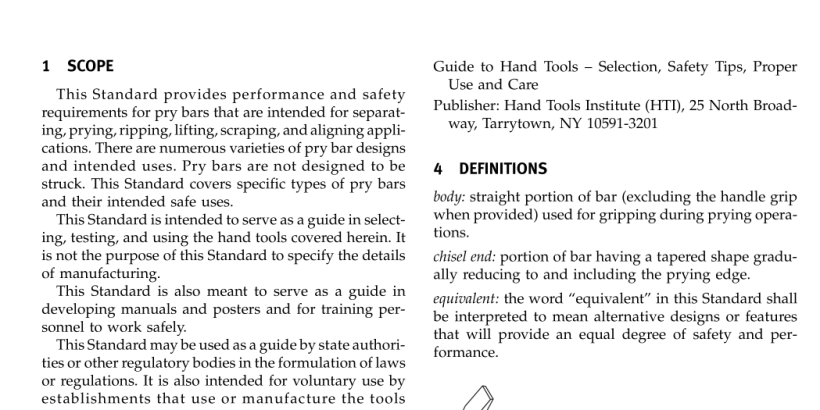ASME B107.60-2004 pdf free download.Pry Bars.
handle: additional material that is securely attached to the body and is to be gripped during use. point end: portion of bar having a tapered, round, cross- sectional area that is intended for aligning applications.
prying edge: edge formed by the tapering of the chisel end or claw end.
prying end: portion of bar having a chisel end or a claw end. safety message: information imprinted on or affixed to the bar that is intended to promote safety. shall and should: mandatory requirements of this Stan- dard are characterized by the word “shall.” Ifa provision is of an advisory nature, it is indicated by the word “should” or is stated as a recommendation. 5 REQUIREMENTS Pry bars shall pass the tests specified in para. 6 as applicable.
5.1 Design
5.1.1 Type I: Close Quarter. Pry bars shall have a sharply bent chisel end providing leverage in limited space applications and a pointed end for alignment applications.
5.1.2 Type II: Die Setter. Pry bars shall have a bent halfloop chisel end for separatingor pryingapplications and a straight chisel end for scraping or prying.
5.1.3 Type III: Handled. Pry bars shall have a slightly bent chisel end for separating, scraping, or prying applications and a handle grip.
5.1.4 Type IV: Pinch. Pry bars shall have a slightly bent chisel end for separating, scraping, or prying appli- cations and a pointed end for alignment applications.
5.1.5 Type V: Rolling Head. Pry bars shall have a formed rounded chisel end that acts as a fulcrum to provide leverage and a pointed end for alignment applications.
5.2 Materials The materials used in the manufacture of pry bars shall be such as to produce pry bars conforming to the requirements specified herein.
5.3 Mechanical Properties Pry bars shall have a maximum hardness of 50 HRC or equivalent.
5.4 Surface Conditions Pry bars shall be free of nonfunctional sharp edges, points, and surface roughness that could inflict personal injury to the user or adversely affect performance.
6 TESTS Many tests required herein are inherently hazardous and adequate safeguards for personnel and property shall be employed in conducting such tests. Tests shall be conducted at a temperature between 40°F and 90°F. Separate (new) samples shall be used for each test. Failure to meet the requirements of the applicable tests indicates that the pry bars do not comply with this Standard.
6.1 Hardness Hardness determination shall be made in accordance with ASTM E18.
6.2 Prying Tests
6.2.1 Prying End Test. The load shall be applied near the middle of the handle or grip area of the pry bar (see Fig. 6). Apply a slow, steady load to the pry bar to meet the torque specified in Table 1. If the blade or tip fails, takes a permanent set, or if the handle loosens from the pry bar, the pry bar has failed this test.
6.2.2 Point End Test. The load shall be applied near the middle of the handle or grip area of the pry bar (see Fig. 7). Apply a slow, steady load to the pry bar to meet the minimum bend angle specified in Table 2. The pry bar shall not fracture before the minimum bend angle is achieved.
6.3 Handle Solvent Resistance Test Assembled pry bar handles shall be fully immersed in the test fluids specified (new samples shall be used for each testfluid) for 15 minto 20 min atroom temperature, removed, and let stand for 24 hr to 48 hr. Test fluids are SAE J1703 brake fluid, gasoline, ethylene glycol, and ethyl alcohol. There shall be no significant swelling nor surface attack of the material being tested.ASME B107.60 pdf download.ASME B107.60-2004 pdf free download
